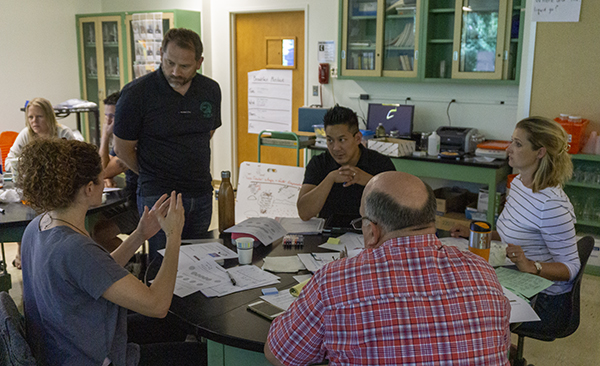 Ben Fell (standing), Sacramento State civil engineering chair, works with math and science teachers during an annual weeklong summer institute aimed at helping them improve their teaching and leadership skills. (Sacramento State/Jonathan Morales)
Ben Fell (standing), Sacramento State civil engineering chair, works with math and science teachers during an annual weeklong summer institute aimed at helping them improve their teaching and leadership skills. (Sacramento State/Jonathan Morales)By Jonathan Morales
In a Sequoia Hall lab in late June, civil engineering chair Ben Fell is teaching an attentive class about Newton’s Third Law of Physics. Earlier, they learned how to use their smart phone as an accelerometer, and later, they’ll break into groups and design a crash-test car.
It’s the type of classroom scene that plays out nearly every day at Sacramento State. Except Fell isn’t teaching college students. He’s teaching 19 Sacramento-area math and science teachers who are in the middle of an intense, five-year professional development program led by University faculty in the College of Education.
The SacMAST-L (Sacramento Math and Science Teacher Leaders) program is funded through a $2 million National Science Foundation grant. And behind the big acronym is a big idea: If Sacramento State’s faculty experts can help participants become better teachers as well as leaders in their schools and districts, the effect can ripple throughout the region and beyond.
“It’s not just a five-year program that’s going to benefit these 19 teachers and their high school students,” said SacMAST-L project director Jenna Porter, an associate professor of education. “We want them to develop their leadership capacity so they can disseminate new strategies and effective teaching practices and move it into their districts.”
The participating teachers began their instruction when SacMAST-L began in 2016 and are in the fourth year of the program. SacMAST-L was initiated in part to address the frustration teachers feel in trying to implement the latest statewide math and science standards. Classroom teachers were recruited from the area’s three largest high-need school districts: Sacramento City, Elk Grove and San Juan. Participants committed to engage in professional learning while continuing to teach in the classroom during the five years of the program, which ends in 2020.
The program has four major components: Train participants to effectively teach statewide standards; engage them in classroom research that allows reflection on their teaching practices, and make improvements based on the findings; help enable them to better teach and serve students from diverse cultural backgrounds; and build their leadership skills so they can effectively share what they learn within their schools and districts.
Each year’s session begins with a weeklong summer institute at Sacramento State, where teachers learn strategies and skills – such as how to teach Newton’s Third Law – to take back to their classrooms. During the academic year following their summer session, they conduct research and participate in additional professional learning. Sacramento State project directors meet with participants monthly to check their progress and offer feedback.
Nina Collins, a math and physics teacher at Kit Carson International Academy in Sacramento, had recently completed her master’s degree in STEM education and was looking for additional professional growth when she applied to SacMAST-L. She said the support of her program colleagues and the opportunity to learn skills such as new grading techniques have been invaluable.
Collins said that when she reflects on her first three years of participation, she considers the research she has presented and the professional development she has experienced and feels a significant level of achievement.
“Seeing that I’ve been able to do these things successfully, and seeing what they’ve brought to me professionally, it just leads to more confidence going forward,” Collins said.
The three school districts involved serve about 160,000 students, more than two-thirds of them non-white. Teachers in the program are being trained in “culturally responsive” practices to help them work with diverse student populations. Skills learned include becoming adept in parent-teacher home visits and establishing a respectful classroom culture.
“I’ve already seen several of these teachers grow in their working with parents of students,” said Sarah Ives, an associate professor of education and another SacMAST-L project director. The program, she said, also promotes access to and equity in STEM fields.
“If they’re teaching in this more culturally responsive and self-reflective way, their students will see themselves as future mathematicians and scientists,” Ives said.
Porter said that, partly because participants remain in the classroom throughout the five-year duration, the program strengthens the bond between Sacramento State and regional stakeholders in education.
“Sacramento State is an emerging leader in community service and community partnerships,” she said. “Our school district partners can look to Sacramento State for support on professional learning.”
